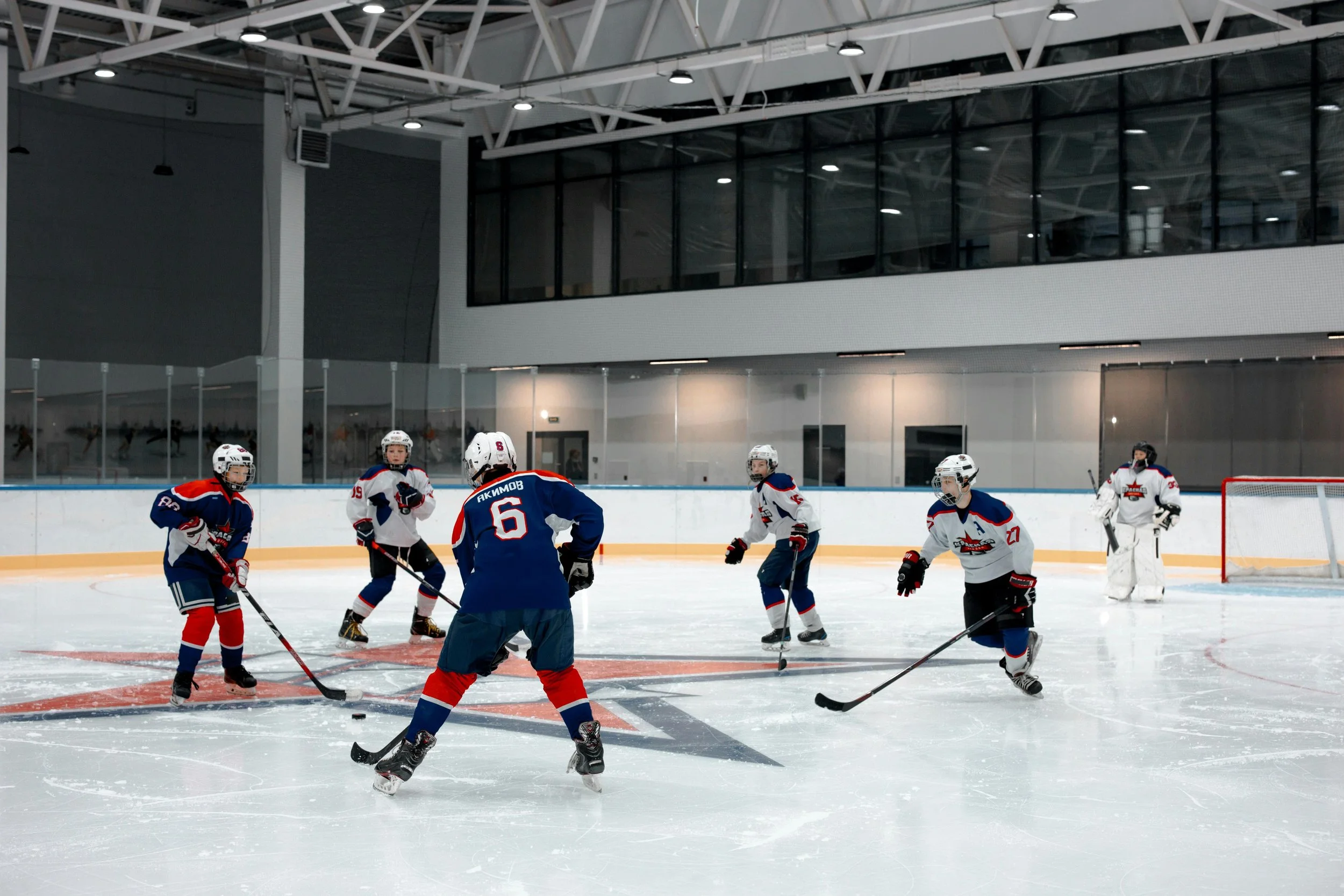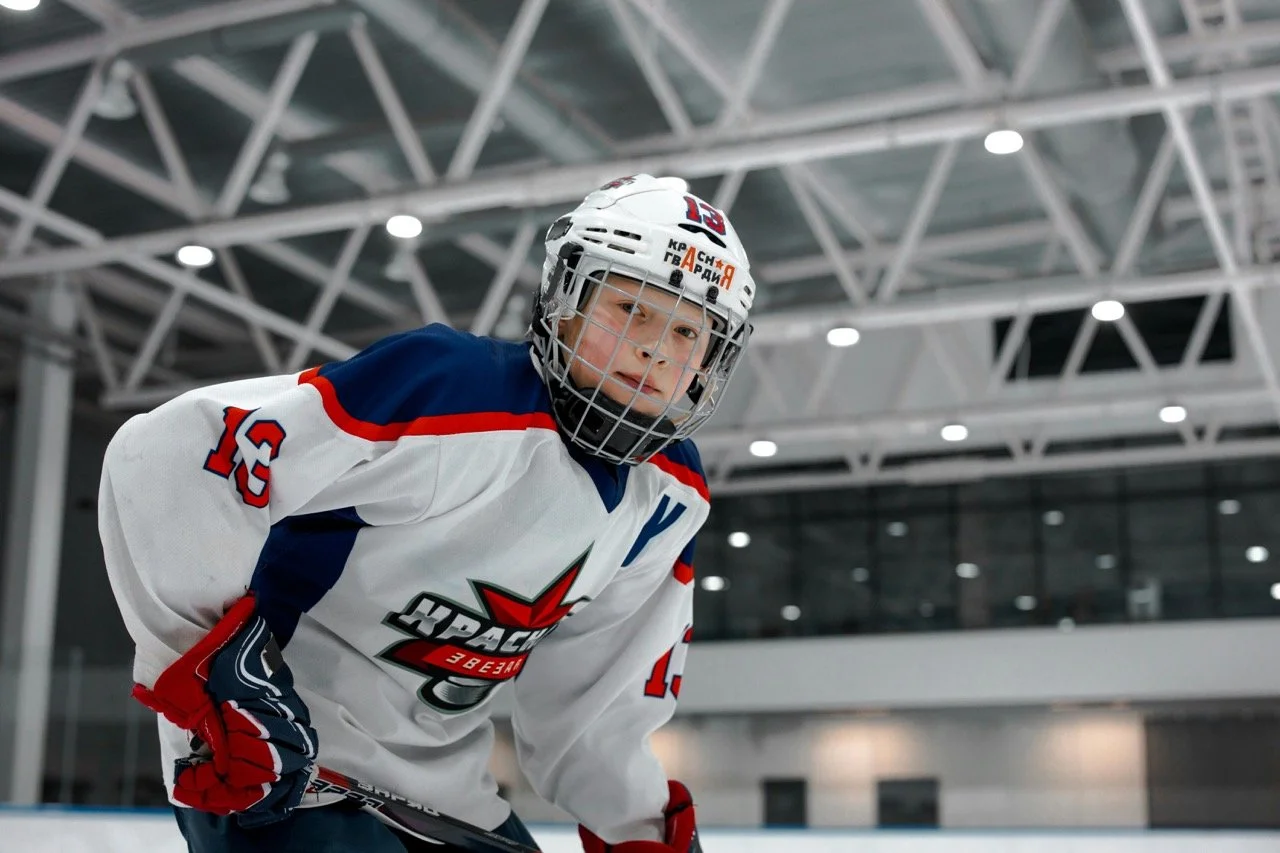Hockey Performance Analysis
Player Information:
Name: Brett Stevens
Jersey Number: 5
Jersey Color: Red
Age: 11
Position: Forward
Shot: Right
Level: Youth AAA
Skating Evaluation:
Forward Skating
Acceleration & Starts
The player shows average initial quickness. His first 3-5 strides are effective for engaging in plays but do not consistently create significant separation from opponents offensively. He can close gaps defensively on players of similar speed but may struggle against quicker opponents. Scoring chances are more often created through positioning rather than pure speed off a start.
Stride Mechanics
At full speed, the player's stride is functional. He achieves near-full leg extension, but could benefit from a deeper knee bend (closer to the optimal 45 degrees) to generate more power. His feet return effectively under his body, maintaining good balance. The return rate is adequate but could be more rapid to increase overall speed.
Agility & Mobility
The player moves adequately in all directions. He shows comfort using crossovers to build speed on turns, primarily on his dominant side. Crossovers are used in both offensive rushes and defensive tracking. His pivots from forward to backward are functional but lack high-end speed and fluidity, which can be an area for improvement to enhance defensive effectiveness.
Backward Skating
Balance & Gap Control
Backward skating appears balanced, and he does not fall easily. He maintains his footing when engaging with opponents. Gap control is an area for development; while he can match the speed of some forwards, quicker skaters can challenge his ability to take away time and space effectively. His backward crossovers and C-cuts show a solid base but could be more explosive to improve backward acceleration and lateral movement.
Falling & Recovery
When the player does fall, he demonstrates the ability to return to his feet quickly and re-engage in the play.
Puck Skills Evaluation:
Stickhandling
The player displays more comfort and control handling the puck on his forehand. His wrist roll is developing appropriately. He can handle the puck in open ice but tends to look down at the puck when under pressure or in traffic, which limits his vision of the ice. The backhand is less developed, with puck control being an area for focused improvement. Puck protection skills need refinement to maintain possession against defensive pressure.
Passing & Receiving
Passing
He can execute hard, flat passes on his forehand with reasonable accuracy. His backhand passes are less frequent and less crisp. He does not utilize the saucer pass often.
Receiving
The player can receive soft to medium-paced passes on his forehand cleanly. He shows some difficulty handling very hard passes or passes on his backhand, where the puck may bounce off his stick. Improving his ability to cushion and control all types of passes would enhance his effectiveness as a playmaker.
Shooting Evaluation:
Shot Analysis
Forehand Wrist Shot
This is his primary shot type. The release is moderately quick, and he demonstrates an ability to aim for the net, though not consistently targeting specific corners. The shot has average power for his age group. While he can score with it, it is not yet an overwhelming scoring threat from a distance; chances are higher from closer range.
Other Shots
The video did not provide clear examples of snap shots, slap shots, or one-timers to evaluate. His backhand shot appears to be a developing skill, used more for directing pucks toward the net than for powerful scoring attempts.
Net-Front Presence
The player shows a willingness to go to the net-front area, creating opportunities for screens or potential redirections. His hand-eye coordination for tipping pucks is a developing skill.
Physical Engagement:
The player is a willing participant in physical battles, particularly along the boards for puck possession. He does not shy away from contact but is more reactive than proactive in initiating it. He engages honestly and does not take unnecessary penalties. When receiving contact, his balance is adequate but could be improved. A stronger base would make him more difficult to knock off the puck. Currently, stronger opponents can win physical battles against him. He is neither timid nor overly aggressive, displaying a brave but controlled approach to physical play.
Hockey IQ & Game Sense:
Effort & Positioning
Effort
The player demonstrates a consistent and high level of effort in all three zones. He works hard on both the forecheck and the backcheck, showing a desire to regain puck possession rather than waiting for teammates.
Offensive Positioning
He understands how to find open ice and make himself available for a pass, particularly in the slot area. He provides good support to his teammates who have the puck and shows a basic understanding of offensive zone concepts.
Defensive Positioning
He is generally responsible defensively, attempting to stay above the puck and cover his assigned player. At times, he can become focused on the puck, losing track of his defensive assignment. His stick positioning defensively is an area for improvement to better take away passing lanes.
Decision Making & Vision
Under pressure, his decision-making can be rushed, sometimes leading to turnovers. He can identify what the opposing team is trying to do on a basic level. His vision is developing; he sees the immediate play well but could improve his ability to anticipate the next sequence of events. He understands basic team concepts like zone entries and defensive responsibilities.
On-Ice Demeanor:
Body Language
The player exhibits positive body language throughout the game. He does not show visible frustration after a mistake and gets up quickly to rejoin the play after being knocked down.
Sportsmanship
He appears to be a good teammate, engaging with others on the bench between shifts. There were no instances of negative engagement with the opposing team or officials. He acts as a positive catalyst through his consistent effort.
Physical Profile:
Height: Average (for age group)
Weight: Average (for age group)
Strength: Average
Shot: Right

Player Scorecard: Brett Stevens (#5)
Rating Scale: 1 (Poor) to 10 (Exceptional)
Offensive Play
Skating: Acceleration
Puck Control
Passing
Shooting: Accuracy
Shooting: Power
Offensive IQ
Defensive Play
Skating: Gap Control
Defensive Positioning
Stick Positioning
Effort / Backcheck
Physical Engagement
Defensive IQ
Rating
5
5
6
5
4
6
Rating
5
6
5
7
5
6
Summary and Recommendations
Overall, Brett Stevens is a hard-working forward with a solid foundation in positioning and effort. His hockey sense is above average for his age, and he consistently puts himself in good positions offensively. His positive attitude and consistent work rate make him a valuable team player.
To elevate his game, the following areas are recommended for focus:
Skating Power and Agility
Focus on off-ice strength training (squats, lunges) and on-ice drills that emphasize deep knee bend to increase stride power. Agility drills focusing on quicker, more fluid pivots from forward to backward will improve his transitional play.
Puck Control Under Pressure
Practice stickhandling with his head up, using drills that force him to navigate obstacles without looking at the puck. Incorporate drills where he must protect the puck from a checking player to build strength and better habits.
Shot Quickness and Power
Increase shot power through proper weight transfer and core engagement. Practicing quick-release snap and wrist shots will make him a more dangerous scoring threat. Work on receiving passes and shooting in one motion.
Backhand Skill Development
Dedicate practice time to improving backhand passing, receiving, and shooting to become a more versatile, dual-threat player.
Continued dedication to these specific skills, combined with his strong work ethic, will significantly contribute to his overall development as a hockey player.
GameRun’s Sports Video LLM
Enhance Performance: Perfect technique, optimize positioning, refine tactics, and strengthen mindset with AI-driven insights.
Baseball Sports Video Analysis
See how GameRun’s video analysis system evaluates baseball performance in real-time. From swing mechanics to fielding posture, this AI-powered tool gives detailed insights that help players train smarter and reach their full potential.
Basketball Sports Video Analysis
This video demonstrates GameRun’s advanced Sports LLM in action during a basketball game. Watch how gameplay footage is reviewed to provide expert feedback on positioning, technique, and in-game decisions — helping athletes and coaches pinpoint exactly where improvements are needed.
Taekwondo Sports Video Analysis
This video showcases GameRun’s video analysis feature in action during a taekwondo session. See how session footage is captured, displayed, and integrated with performance insights — helping coaches and athletes review form, track technique, and improve with every ride.
Weightlifting Sports Video Analysis
This video showcases GameRun’s video analysis feature in action during a weightlifting session. See how session footage is captured, displayed, and integrated with performance insights — helping coaches and athletes review form, track technique, and improve with every ride.
Cycling Sports Video Analysis
This video showcases GameRun’s video analysis feature in action during a cycling session. See how session footage is captured, displayed, and integrated with performance insights — helping coaches and athletes review form, track technique, and improve with every ride.

















